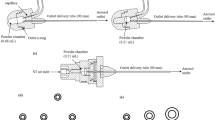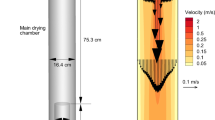Abstract
The objective of this study was to develop a new high-efficiency dry powder inhaler (DPI) that can effectively aerosolize large masses (25–100 mg) of spray dried powder formulations. The DPI was designed to implement a concept similar to a fluidized bed for aerosolization using small mixing balls made of polytetrafluoroethylene along with a larger, hollow dosing sphere filled with the powder. The performance of the fluidized bed DPI was compared, based on emitted dose (ED) and aerosolization efficiency, to other recently developed capsule-based DPIs that were designed to accommodate smaller powder masses (~2–20 mg). The inhalers were tested with spray dried excipient enhanced growth (EEG) formulations that contained an antibiotic (ciprofloxacin) and hygroscopic excipient (mannitol). The new fluidized bed design produced an ED of 71% along with a mass median aerodynamic diameter of 1.53 μm and fine particle fractions <5 and 1 μm of 93 and 36%, respectively, when used to deliver a 100 mg loaded mass of EEG powder with the advantage of not requiring multiple capsules. Surprisingly, performance of the device was further improved by removing the mixing balls from the inhaler and only retaining the dose containment sphere.



Similar content being viewed by others
Abbreviations
- AS:
-
Albuterol sulfate
- Cipro:
-
Ciprofloxacin hydrochloride
- DPI:
-
Dry powder inhaler
- ED:
-
Emitted dose
- EEG:
-
Excipient enhanced growth
- FB:
-
Fluidized bed
- FPF:
-
Fine particle fraction
- HPLC:
-
High-performance liquid chromatography
- HPMC:
-
Hydroxypropyl methylcellulose
- MMAD:
-
Mass median aerodynamic diameter
- MT:
-
Mouth-throat
- PTFE:
-
Polytetraflouroethylene
- PVDF:
-
Polyvinylidene fluoride
- SD:
-
Standard deviation
References
Behara, S. R. B., D. R. Farkas, M. Hindle, and P. W. Longest. Development of a high efficiency dry powder inhaler: effects of capsule chamber design and inhaler surface modifications. Pharm. Res. 31:360–372, 2014.
Behara, S. R. B., P. W. Longest, D. R. Farkas, and M. Hindle. Development and comparison of new high-efficiency dry powder inhalers for carrier-free formulations. J. Pharm. Sci. 103:465–477, 2014.
Below, A., D. Bickmann, and J. Breitkreutz. Assessing the performance of two dry powder inhalers in preschool children using an idealized pediatric upper airway model. Int. J. Pharm. 444(1–2):169–174, 2013.
Bilton, D., P. Robinson, P. Cooper, C. G. Gallagher, J. Kolbe, H. Fox, A. Jaques, and B. Charlton. Inhaled dry powder mannitol in cystic fibrosis: an efficacy and safety study. Eur. Respir. J. 38(5):1071–1080, 2011.
Corcoran, T. E., R. Venkataramanan, R. M. Hoffman, M. P. George, A. Petrov, T. Richards, S. Zhang, J. Choi, Y. Y. Gao, C. D. Oakum, R. O. Cook, and M. Donahoe. Systemic delivery of atropine sulfate by the microdose dry-powder inhaler. J. Aerosol. Med. Pulm. Drug Deliv. 26(1):46–55, 2013.
de Boer, A. H., P. Hagedoorn, R. Woolhouse, and E. Wynn. Computational fluid dynamics (CFD) assisted performance evaluation of the Twincer™ disposable high-dose dry powder inhaler. J. Pharm. Pharmacol. 64(9):1316–1325, 2012.
Geller, D. E., J. Weers, and S. Heuerding. Development of an inhaled dry-powder formulation of tobramycin using PulmoSphere™ technology. J. Aerosol. Med. Pulm. Drug Deliv. 24(4):175–182, 2011.
Grasmeijer, F., P. Hagedoorn, H. W. Frijlink, and A. H. de Boer. Characterisation of high dose aerosols from dry powder inhalers. Int. J. Pharm. 437(1–2):242–249, 2012.
Green, D. W. Perry’s Chemical Engineers’ Handbook (7th ed.). New York: McGraw-Hill, 1997.
Hindle, M., and P. W. Longest. Condensational growth of combination drug-excipient submicrometer particles for targeted high efficiency pulmonary delivery: evaluation of formulation and delivery device. J. Pharm. Pharmacol. 64(9):1254–1263, 2012.
Hindle, M., and P. W. Longest. Quantitative analysis and design of a spray aerosol inhaler. Part 2: improvements in mouthpiece performance. J. Aerosol. Med. Pulm. Drug Deliv. 26(5):237–247, 2013.
Hinds, W. C. Aerosol Technology: Properties, Behavior, and Measurement of Airborne Particles. New York: Wiley, 1999.
ICRP. Human Respiratory Tract Model for Radiological Protection. New York: Elsevier Science Ltd., 1994.
Islam, N., and M. J. Cleary. Developing an efficient and reliable dry powder inhaler for pulmonary drug delivery—a review for multidisciplinary researchers. Med. Eng. Phys. 34:409–427, 2012.
Keller, Manfred., and Joerg. Schierholz. Have inadequate delivery systems hampered the clinical success of inhaled disodium cromoglycate? Time for reconsideration. Expert Opin. Drug Deliv. 8(1):1–17, 2010.
Lind, T., S. Danner, and S. Guentay. Monodisoerse fine aerosol generation using fluidized bed. Powder Technol. 199(3):232–237, 2010.
Longest, P. W., and M. Hindle. Quantitative analysis and design of a spray aerosol inhaler. Part 1: effects of dilution air inlets and flow paths. J. Aerosol. Med. Pulm. Drug Deliv. 22(3):271–283, 2009.
Longest, P. W., Y.-J. Son, L. T. Holbrook, and M. Hindle. Aerodynamic factors responsible for the deaggregation of carrier-free drug powders to form micrometer and submicrometer aerosols. Pharm. Res. 30:1608–1627, 2013.
Prenni, A. J., R. L. Siefert, T. B. Onasch, M. A. Tolbert, and P. J. DeMott. Design and characterization of a fluidized bed aerosol generator: a source for dry, submicrometer aerosol. Aerosol Sci. Technol. 32(5):465–481, 2000.
Prime, D., A. C. Grant, A. L. Slater, and R. N. Woodhouse. A critical comparison of the dose delivery characteristics of four alternative inhalation devices delivering salbutamol: pressurized metered dose inhaler, Diskus inhaler, Diskhaler inhaler, and Turbuhaler inhaler. J. Aerosol Med. 12(2):75–84, 1999.
Rissler, Jenny., Lars. Asking, and Jakob. Kisbye Dreyer. A methodology to study impactor particle reentrainment and a proposed stage coating for the NGI. J. Aerosol. Med. Pulm. Drug Deliv. 22(4):309–316, 2009.
Ruppert, C., T. Kuchenbuch, M. Boensch, S. Schmidt, U. Mathes, V. Hillebrand, I. Henneke, P. Markart, I. Reiss, R. T. Schermuly, W. Seeger, and A. Gunther. Dry powder aerosolization of a recombinant surfactant protein-C-based surfactant for inhalative treatment of the acutely inflamed lung. Crit. Care Med. 38(7):1584–1591, 2010.
Sham, J. O.-H., Y. Zhang, W. H. Finlay, W. H. Roa, and R. Lobenberg. Formulation and characterization of spray-dried powders containing nanoparticles for aerosol delivery to the lung. Int. J. Pharm. 269:457–467, 2004.
Smith, I. J., J. Bell, N. Bowman, M. Everard, S. Stein, and J. G. Weers. Inhaler devices: what remains to be done? J. Aerosol. Med. Pulm. Drug Deliv. 23:S25–S37, 2010.
Son, Y.-J., P. W. Longest, and M. Hindle. Aerosolization characteristics of dry powder inhaler formulations for the excipient enhanced growth (EEG) application: effect of spray drying process conditions on aerosol performance. Int. J. Pharm. 443:137–145, 2013.
Son, Y.-J., P. W. Longest, G. Tian, and M. Hindle. Evaluation and modification of commercial dry powder inhalers for the aerosolization of submicrometer excipient enhanced growth (EEG) formulation. Eur. J. Pharm. Sci. 49:390–399, 2013.
Tian, G., P. W. Longest, X. Li, and M. Hindle. Targeting aerosol deposition to and within the lung airways using excipient enhanced growth. J. Aerosol. Med. Pulm. Drug Deliv. 26(5):248–265, 2013.
Tiddens, H. A., D. E. Geller, P. Challoner, R. J. Speirs, K. C. Kesser, S. E. Overbeek, D. Humble, S. B. Shrewsbury, and T. A. Standaert. Effect of dry powder inhaler resistance on the inspiratory flow rates and volumes of cystic fibrosis patients of six years and older. J. Aerosol Med. Depos. Clear. Eff. Lung 19(4):456–465, 2006.
Weers, J. G., R. C. Andrew, N. Rao, K. Ung, A. Haynes, S. K. Khindri, S. A. Perry, S. Machineni, and P. Colthorpe. In vitro–in vivo correlations observed with indacaterol-based formulations delivered with the breezhaler®. J. Aerosol. Med. Pulm. Drug Deliv. 2014.
Young, P. M., J. Crapper, G. Philips, K. Sharma, H.-K. Chan, and D. Traini. Overcoming dose limitaitons using the orbital multi-breath dry powder inhaler. J. Aerosol. Med. Pulm. Drug Deliv. 26:1–10, 2013.
Zhou, Qi., Patricia. Tang, Sharon. Shui. Yee. Leung, John. Gar. Yan. Chan, and Hak.-Kim. Chan. Emerging inhalation aerosol devices and strategies: where are we headed? Adv. Drug Deliv. Rev. 75:3–17, 2014.
Zhu, J., and Y. Ma. A New breath-activated, excipient-free dry powder inhaler and a rotating fluidized bed powder dispenser for pulmonary drug delivery. Respir. Drug Deliv. 925–930:2006, 2006.
Acknowledgments
The authors gratefully acknowledge financial support from the National Heart, Lung, and Blood Institute through Award R01 HL107333. The content is solely the responsibility of the authors and does not necessarily represent the official views of the National Heart, Lung, and Blood Institute or the National Institutes of Health.
Conflict of interest
The authors are employees of Virginia Commonwealth University. Virginia Commonwealth University is seeking patent protection with respect to the technology described, which if licensed may result in a financial interest to the authors.
Author information
Authors and Affiliations
Corresponding author
Additional information
Associate Editor John H. Linehan oversaw the review of this article.
Rights and permissions
About this article
Cite this article
Farkas, D.R., Hindle, M. & Longest, P.W. Characterization of a New High-Dose Dry Powder Inhaler (DPI) Based on a Fluidized Bed Design. Ann Biomed Eng 43, 2804–2815 (2015). https://doi.org/10.1007/s10439-015-1335-2
Received:
Accepted:
Published:
Issue Date:
DOI: https://doi.org/10.1007/s10439-015-1335-2




